
16-23 January 2017. So we’re sitting in the open-air breakfast area at Nomadis Hostel in Merida on the fourth of January. We’ve just about finished breakfast when we get chatting with a couple sitting near us. They tell us about an upcoming festival in Chiapa de Corzo. A festival! Nearby, and soon! I am immediately interested. Latin American festivals are among the best in the world and Mexico is no exception. We went to the Guelaguetza Festival in Oaxaca several years ago and it remains one of the highlights of our travels.
Situated on the banks of the Rio Grijalva, in the state of Chiapas, in the far south of Mexico, is Chiapa de Corzo, one of Mexico’s Pueblos Mágicos or magic towns. There’s a magical feeling in the cobbled streets and colonial architecture, but it’s during the festival that the magic really happens. Every year Chiapa de Corzo is home to the Fiesta Grande de Enero, or the Great Festival of January.
16 January. On the first day: we arrive at about 4:00 pm, settle into our hotel room, and after dinner wander down to the fair in the main square. It’s huge. And loud. Every ride is vying with every other ride to be the loudest and brightest. Shops and makeshift restaurants lining the streets that border the square have their own loudspeakers booming music to entice customers. Crowds of people fill the space, eating dinner and enjoying the rides. It’s party time!



We’ve not been able to get any useful information from the hotel about the events of the next several days. There is no printed program, but in amongst the rides and the food carts and vans and temporary stalls and restaurants in the town square we find a tiny tourist information booth. From the man there we glean – be at the church tomorrow morning at ten. That much Spanish we do know: Iglesia, diez a la mañana.
The Fiesta Grande de Enero is a celebration of Our Lord of Esquipulas, San Antonio Abbott, and San Sebastian, the patron saints of Chiapa de Corzo, but it is much more than that.
In 1711 a Spanish woman named Maria de Angulo came from Guatemala with her ailing son. She found a cure for him in Chiapa de Corzo. The story goes that several years later when a plague of locusts destroyed the crops in the area, she returned, and in gratitude for her son’s recovery she gave out food and coins to the people of the village. As her servants distributed the alms they cried out “para chicos” which means “for the children”. Today the men, and some women, of the village dress in light skinned masks and straw hair to resemble the fair skin and light hair of the Spanish people who helped their village. They are known as Parachicos – for the children. But perhaps the name came from an earlier event. While the ailing boy was still in the village a man dressed up as a kind of clown, in a light coloured mask and hair to imitate the Spanish, and danced to entertain the child. His dance was “para el chico” – for the boy.
The women of the village, known as Chiapanecas and representing femininity and strength, dress in elaborate colourful embroidered dresses dating from the early 1900’s. The third important character in this grand theatre is the Chunta. Chuntas are men dressed as women in the clothing of Spanish servants of the 1700’s. They represent and pay homage to the servants of Maria de Angulo who distributed the food and coins to the children during the famine.
17 January. On the second day: We get to the church at about ten and find people starting to gather inside and out.

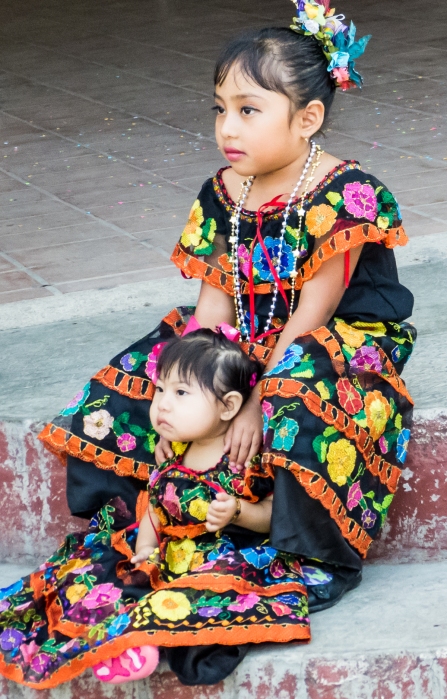
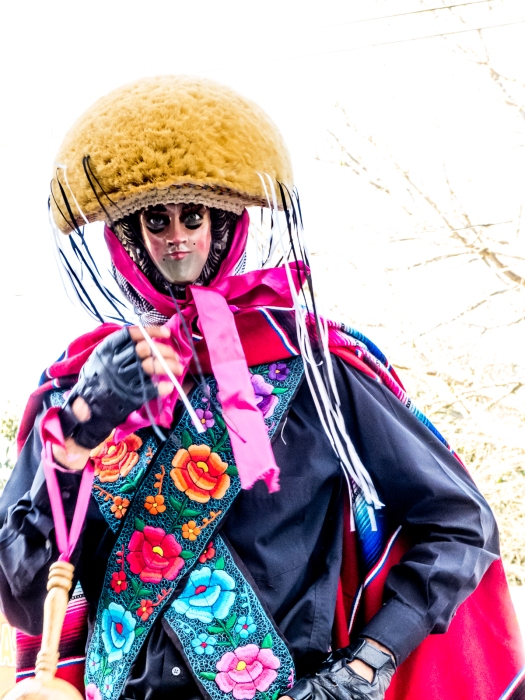

The band is waiting until it’s time to play.
A mass is held in the church, as gradually more and more people arrive. They come storming along the road towards the church, skirts and serapes flying, their rattles, known as chinchines, sounding out a steady rhythm with their chanting. It’s only the beginning, and the energy that will carry them through the day fills the air.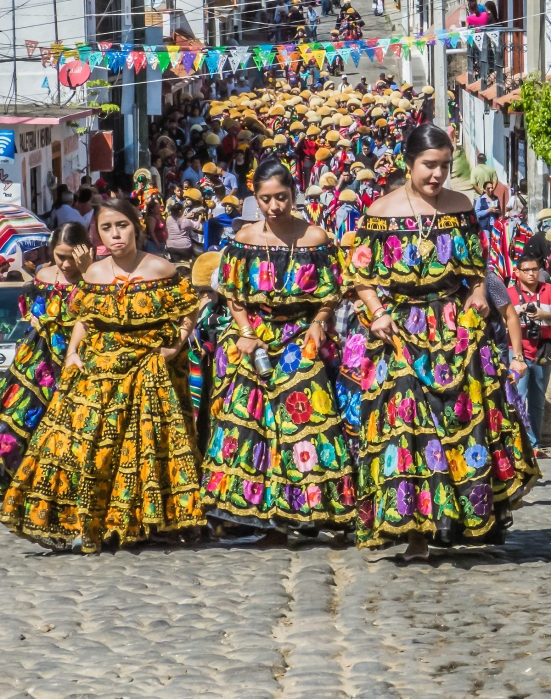
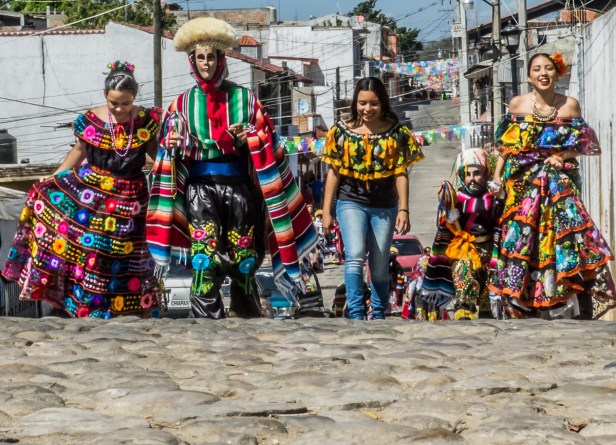

By the end of the mass there are hundreds of Parachicos and Chiapanecas assembled.
Those inside the church emerge carrying huge colourful banners and the statues of the saints.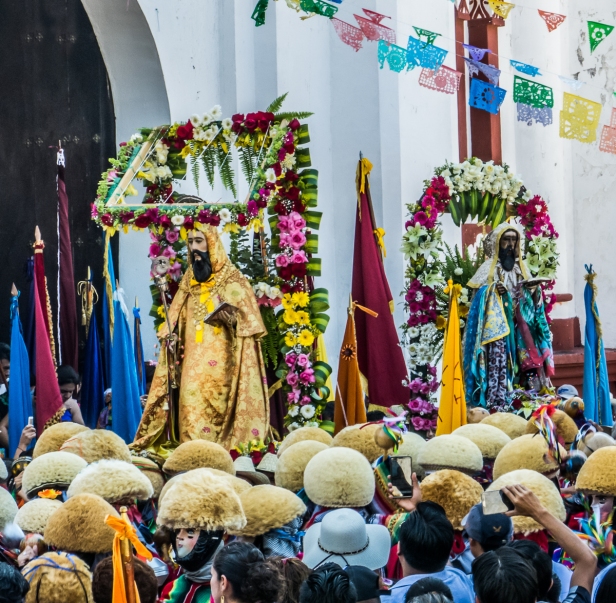
The parade begins. The dance is a prayer, an offering of gratitude, and an offering to the saints. Their leader, or Patron, plays the flute and chants praises. The Parachicos respond with cheers.
We follow the parade for a while and then find a place upstairs in one of the buildings lining the town square. Here we can watch without the threat of having our limbs crushed by the crowd.
We go back to the town square at night to find the Chiapanecas and Parachicos still on the move.
Throughout the day they paraded through the streets dancing and chanting and shaking their chinchines, led by the drums and flute. They visited several churches, the cemetery, and the family chapels of San Antonio and San Sebastian. They come parading by, straggling now, slowly breaking up into smaller groups, lifting off their masks and headdresses.
Walking home we pass a group of them drinking micheladas – a horrible mix of beer, lime juice, assorted spices, and tomato juice, in a huge salt-rimmed plastic cup. They’re sitting at a table in the street. Music, as always, booms out from somewhere. As we pass I reach out to touch a headdress sitting on the table. The headdresses, hand-made from yucca fibre, feel like stiff brushes. One thing leads to another. We are both encouraged to try on the outfits. Don becomes a Parachico and one of the Chiapanecas pulls him dancing into the street.

18th January. On the third day: We go searching for the family chapel of San Sebastian. Each year for twelve months a different family guards the sacred image of San Sebastian, and another guards the sacred image of San Antonio. The front courtyard and front room of the family home is turned into a chapel and dedicated to the saint. A huge “ceiling” of food – fruit and breads – is created by local schools and other groups and mounted in the entrance. It is left hanging there for several days. We’ve already found the family chapel for San Antonio, as it is right next door to our hotel. Since we’ve arrived part way through the festival we know the major celebrations for San Antonio are over, and the ceiling of fruit and bread has already been removed, but the festivities for San Sebastian are about to begin and we want to know where. It seems not even the locals know. We ask in the tourist office on the way down to the river front. They don’t know. They don’t even have a program for the festival for 2017 though they do give us one for 2016. We ask in the street and are given wrong directions. We ask again and again and finally our perseverance pays off.
The aroma is almost overpowering. The fruit and sweet breads have been hanging in the heat for days. The chapel is filled with flowers.
The sweet scent of the flowers mixed with the rich aroma of ripe oranges, apples, pineapple, papaya, bananas, and melon washes over me like a warm blanket. I almost think I will swoon with the potency of it. The buzzing of swarms of bees fills the air.

The family is seated inside the chapel and one of them speaks English. I am overcome with gratitude. Finally we might get some accurate information about what will happen when. She says to wait around until about two o’clock.
There is a band and piñatas next to the chapel.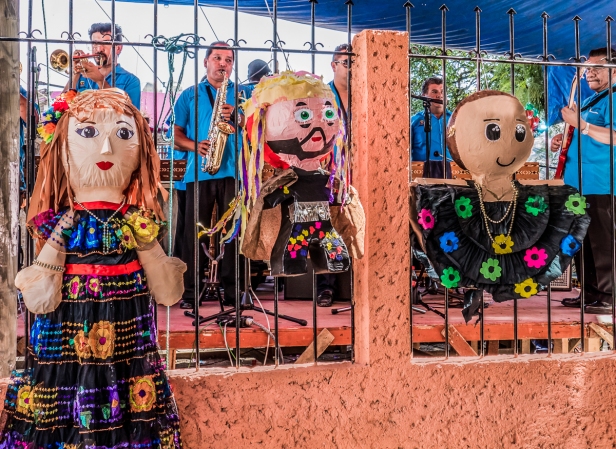

There are groups of Parachicos and Chiapanecas milling about in the street,

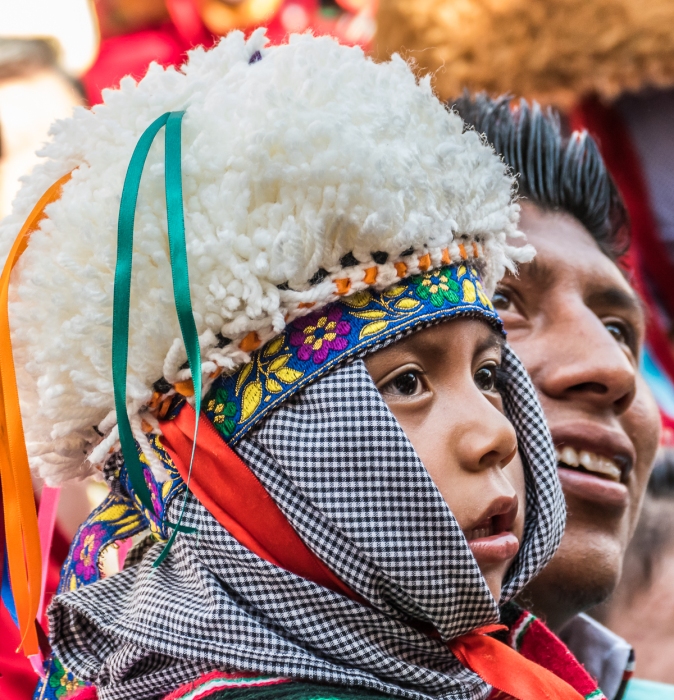
and a crowd starts to gather in the seating provided.
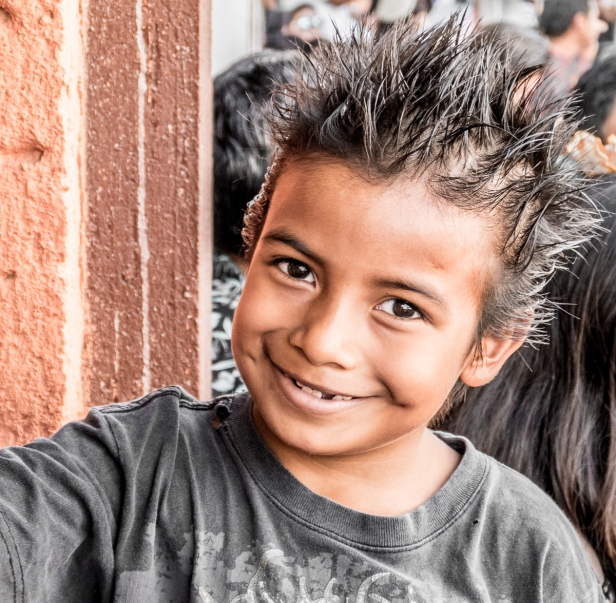
More Parachicos arrive, make sure their outfits are complete and tie on their masks. 

And then the parade arrives. Carrying colourful banners and shaking their chinchines in rhythmic beat the Parachicos and Chiapanecas march up the street towards the chapel.
I do not know how they all fit inside. There is a ceremony inside, perhaps a kind of mass, there is chanting, and singing, and the band plays. And then it is over and everyone emerges back out into the street and the band plays some more.
Everyone, and I do mean everyone, is served drinks, and a small amount of food. The Parachicos rest hot and exhausted in the tropical heat.
We head home for a rest and return in the evening because we have been told there will be Chuntas there, but it is not so. The number of times we tried to find out some kind of schedule, what was happening where, and when, and were given false information was dumbfounding. Many of the locals themselves don’t even know, but somehow it all seems to work.
So we stay for the service and singing, and are given plastic bowls of food at the end. Once again everyone is fed – tamales and something else that I can’t identify, and a bottle of orange pop.
There is loud live music until about three in the morning from the San Antonio chapel next to the hotel. As is usual in many tropical places with traditional Spanish colonial architecture, the high small window in our bathroom has no glass in it, only mesh. We might just as well be at the party next door. We tape my travel pillow over the window to try to block the noise but it doesn’t make much difference. Even with earplugs the beat of the drums remains insistent.
Next post: The fourth, fifth, and sixth days – around the town of Chiapa de Corzo, being refugees from our hotel, and a night of spectacular fireworks.
All words and images by Alison Louise Armstrong unless otherwise noted
© Alison Louise Armstrong and Adventures in Wonderland – a pilgrimage of the heart, 2010-2017.

Wow! Made me smile. What colour and festivity!
LikeLiked by 1 person
Thanks Caroline. I can tell you it made me smile too! 🙂
Alison
LikeLike
Those crowds are overwhelming! I have never seen such a thing as those “wigs,” or what almost look like straw helmets! (They also look like mushrooms when seen from afar or above; they are really one of the strangest things I’ve seen.) I love how you seek out and follow the festivals, and I think one of your greatest photography talents (among many) is the way you capture these events. The perspectives, the colors, the details, and most of all, the faces, are just a beautiful documentation of these colorful traditions.
LikeLiked by 1 person
Thanks Lexie. I love festivals, and I’m always interested in the details, and in trying to capture the feeling of the event. It was so much fun at this one. It was a really high energy party that went on for days. I find that the participants in events like this are deeply committed and that the commitment carries them along and gives them energy they wouldn’t normally have.
I’ve also never seen anything like the “wigs” either – truly unique. I guess they came from someone long long ago making some kind of headdress from the only light coloured material they had. Yucca fibre comes in long strings so maybe they started out way back as long stringy wigs that became more and more formalised over time.
Alison
LikeLiked by 1 person
Alison, this is such a beautiful post. The photos are spectacular and the story so divine. I just love your blog so much. Your posts should be in a NG or Conde Nast. Amazing…always. Such brilliant photography too. Waiting for me!
LikeLiked by 1 person
Oh thank you so much Nicole! That is high praise indeed. I’m so honoured you should think so.
Alison
LikeLiked by 1 person
🙂 Looking forward to your next post.
LikeLiked by 1 person
Thanks for sharing!! Great post and images!!
LikeLiked by 1 person
Thanks so much. I’m glad you enjoyed it!
Alison
LikeLiked by 1 person
I agree with Nicole I think your posts should be in a travel magazine. Each photo more vibrant and beautiful than the next. I’ve never seen these exact costumes but it does remind me of some we saw in Peru.
LikeLiked by 1 person
Thank you so much Sue. Maybe some day a travel mag will “discover” me. I have so much fun with the photography, but the writing can be a bit of a struggle at times. These costumes also reminded of some I’d seen in Peru. I love the bold use of colour throughout Latin America.
Alison
LikeLiked by 1 person
so beautifully all
dressed up
to celebrate
their joyful, gratitude
for being present
in a long line
of human/saints
continuation!
thank you for bringing
me there so fully 🙂
LikeLiked by 1 person
Gratitude for being there
to experience the long
tradition of devotion.
Glad to be able to bring
it to you and all here.
Such a pleasure for me.
Alison
LikeLike
The colours and vibrance of your people photos are incredible. The outfits are amazing and you guys are such troopers for joining in. I love how you seized the opportunity to go to this festival.
LikeLiked by 1 person
Thanks Caroline. I love the way colour is thoroughly embraced by the Latin American countries, and their festival costumes are usually wildly colourful. We love going to festivals, and joining in a little when we can. I was just thrilled with the serendipity that we even heard about it.
Alison
LikeLike
Such amazing photographs!! It must have been quite an exciting experience to be part of the festivities.
LikeLiked by 1 person
Thanks Lieve. It was so exciting to be there. The energy of the dancers and the crowd was amazing. And so much colour!
Alison
LikeLike
Heysus de cristos, lady! What photos here! Those first five or six just stunned me–the color, the style…you’ve advanced toward slightly different something? And you’ve included color without overdoing it at all. I think I’m going to have to visit Canada this summer and take a lesson or two from you! The photo of the little girl from the side looking up–my favorite here, but they’re all unique in their own way. And just how did you do the one with the girl in color and everything else in B&W???
Don’t tell Don, but you look better in the outfit than he does. But doesn’t he look happy? You think it’s the outfit, the tomato juice in his beer, the fiesta, or that girl?
LikeLiked by 1 person
It was the girl BF, definitely the girl. I never did try the micheladas.
LikeLike
Thanks BF! I don’t know what I’ve advanced to – just learning more about LR I guess, plus I had a couple of lessons from my sister last summer. The coloured subject and B&W background is pretty easy really. I’d imagine that’s available in most editing software. Come to Canada! Don was having a fine time. I’m pretty sure it was the girl 🙂
Alison
LikeLike
The opening photo is really great! This looks like a very colorful festival — I can feel the energy and excitement through your beautiful photos. The hanging fruits and sweat breads are something I’ve never seen or heard before. Your perseverance really pays off, Alison!
LikeLiked by 1 person
Thanks Bama. It was an amazing festival. So much fun. I’ve never seen anything like the hanging bread and fruit either. I think it must represent the food that was handed out to the children. It was quite an incredible sight. And the strong aroma was fabulous. That perseverance stems from not wanting to miss out on anything 🙂
Alison
LikeLike
These photos are incredible, Alison – some of your best, especially the first few. My very favorite of all of them is the one near the beginning of the little girl’s head from the side. You are getting better and better all the time. Fiestas!
LikeLiked by 1 person
Thanks so much Kay. That little girl was sitting in the church a couple of rows in front and across the aisle from me. I just kept waiting ’til she turned her head enough. Yes, Fiestas! So much fun.
Alison
LikeLike
Don dressed up! Precious. 🙂 As always love your photos and writing about fiestas. So much color. So much action. So much humanity. Thanks Alison and Don for continuing to bring us the world. –Curt
LikeLiked by 1 person
Thanks Curt. We love the festivals. As you say so much colour, action, humanity. And fun! Chuckle – Don’s always good for a little fancy dress 🙂
Alison
LikeLike
He’d fit right in at Burning Man! 🙂
LikeLiked by 1 person
How can you not take images from such pageantry? Wonderful photos!
LikeLiked by 1 person
Thank you so much. And yes, it all begs to be photographed!
Alison
LikeLike
Thanks for taking us with you through your amazing photos and writing. Mexican festivals are the best! My biggest fear in life is getting pulled in by locals to do dancing. Looks like Don was a good sport.
I really like that opening image – it took me a second to see the two faces. Very nice.
LikeLiked by 1 person
Thanks so much Jeff. I agree, Mexican festivals are the best, though we did go to a really amazing one in Peru. Don loved it! The girl especially 🙂
Alison
LikeLike
Great documentation of the festival.
LikeLiked by 1 person
Thanks so much rabirius, glad you enjoyed it.
Alison
LikeLiked by 1 person
Thanks for so many beautiful fotos
Warm regards rainy cold germany
LikeLiked by 1 person
Thanks Andrea, glad you enjoyed it. We’re back in Vancouver and it’s cold here too, but at least it’s not raining for a change.
Alison
LikeLike
Absolutely beautiful! What dresses, what colors! Wonderful, thanks for sharing.
LikeLiked by 1 person
Thanks so much Cecilia. It was an amazing festival – so much colour and joyful energy!
Alison
LikeLike
What a spectacle! The children are always my favourites, Alison. Those beautiful faces! 🙂 🙂
LikeLiked by 1 person
Isn’t it amazing! We had no idea really what we were going to except for a few photos online, and the expectation that it would be somewhat like the festivals we’d been to in Oaxaca and Peru. And yes I agree about the children – I’m always drawn to them. And they start participating from so young!
Alison
LikeLike
It’s always difficult to get a timetable in Portugal too. We’ve done our share of hanging around waiting but it’s usually wortwhile 🙂
LikeLiked by 1 person
This time it was definitely worthwhile.
LikeLiked by 1 person
Stunning place, Alison and Don! So colorful and lively!
LikeLiked by 1 person
Isn’t it amazing! We’re so glad we went.
Alison
LikeLike
Simply dazzling! I can picture donning the costume of the chiapanecos and maybe the masks and amazing bristle hats worn by the men but I CANNOT imagine topping it off with a colorful blanket in the thick tropical heat of Mexico. As usual, I am totally knocked out by your photos of the people and the profile of the little girl with the yellow flower in her hair is marvelous. Anita
LikeLiked by 1 person
Thanks Anita. Many people seem to like the photo of the little girl. She was sitting across the aisle from me in the church. I had to wait for her to turn her head towards me a little.
The Parachicos must have been sooooo hot. Not only the serape on top of everything, but a full head and neck scarf under the mask and bristle hat. And those masks only have the tiniest holes in them to see through. I don’t know how they do it.
Alison
LikeLike
We never made it this far south in Mexico the year we lived there and we have always regretted it. I guess it just means we need to make another visit. We too love the festivals of Mexico, until it comes time to sleep. And even when there are no major festivals scheduled, the locals seem to find any excuse to celebrate. When we lived in San Antonio Tlayacapan they had a celebration for the construction workers. Wherever construction was taking place, either residential or commercial, workers were there firing off cojetes, beginning at 5:00 in the morning. We were surrounded! Alison, your photos continue to astound me. The clarity and color saturation, the composition, are beautiful. Can I pay you to give me some lessons? 🙂
LikeLiked by 1 person
Thanks so much for your kind words LuAnn. Sure I’ll give you lessons, but you’ll have to come to Vancouver 🙂
I know what you mean about the noise in Mexico, and we found the same in South America too. It’s that Latin enthusiasm!
If you do get back to Mexico I highly recommend the states of Oaxaca and Chiapas. They have the highest numbers of indigenous people so you get to experience the traditional Indian ways – authentic and colourful.
Alison
LikeLiked by 1 person
Vancouver has been on our list so one never knows!
LikeLiked by 1 person
Wow!!! What an amazing experience and wonderful photos. I can’t wait to read the rest!
LikeLiked by 1 person
Thanks s much Mo. It was a really amazing experience. The final post about this festival is coming soon.
Alison
LikeLike
Wow, so much color! Just catching up with your posts after our trip, life, etc. Hope you guys are doing well!
LikeLiked by 1 person
It was a pretty spectacular festival, even if it was difficult to get any kind of programming info. We’re both well but just coming of a much needed fast. In a couple of weeks when we’re eating more regular food again let’s get together and catch up.
Alison
LikeLiked by 1 person
Wow, a fast! Hope it went well. Looking forward to catching up over tacos and margaritas! Haha!! 🙂 K.
LikeLiked by 1 person
I am green with envy at your good fortune to visit Chiapa de Corzo for so many days during the Fiesta Grande de Enero. The depth of your experience shines through in every image. My own limited experience here in 2020 (1 morning) was significantly enhanced by your post and makes me want to return here again next year. Love seeing you both dressed as Parachicos
LikeLiked by 1 person
Thanks Lisa. It was pure serendipity that we even heard about this festival. I’m usually on top of that stuff and festivals is often the first thing I search for when we’re headed somewhere. But this was pure luck. I hope you get back for more of it. It’s pretty wild, but also an incredible experience to be there for several days of it.
Alison
LikeLiked by 1 person
Our visit was pure serendipity too! How lucky are we that Chiapa de Corzo called out to both of us. Can not wait to return there.
LikeLiked by 1 person